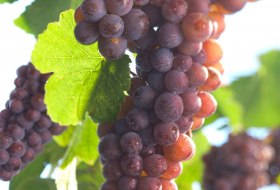The most important of the white Pinot varieties in Rheinhessen is Pinot Gris, which is now grown on 2.050 hectares (8% of the total vineyard).
Scientists say that this grape variety emerged from a bud mutation of Pinot Noir. During the growing season Pinot Noir and Pinot Gris can hardly be distinguished.
Under the synonym "Ruländer" (after its discoverer, the merchant Jakob Ruland), the grape variety was known for sweet and heavy wines for many years. Then, in the mid 1980s, the Italians grabbed the voluminous Ruländer, gave it a rigorous slimming diet and baptised it with a seductive name: Pinot Grigio.
Pinot Gris grows particularly well on calcareous soils. Yield reductions and efficient thinning of the grapes are easily performed and often practiced in order to increase quality.
Typical for Pinot Gris is the scent of green nuts, almonds, fresh butter and fruity aromas remind of pear, dried fruit and raisins, pineapple and citrus fruits. In addition, vegetative notes of green beans or peppers also occur.
Pinot Gris harmonizes well with seafood, strong sea fish, pasta, lamb, wildfowl and young boar and ripe soft cheese. Powerful Pinot Gris from oak barrels are an excellent match for lamb dishes and game - such as birds or deer.



